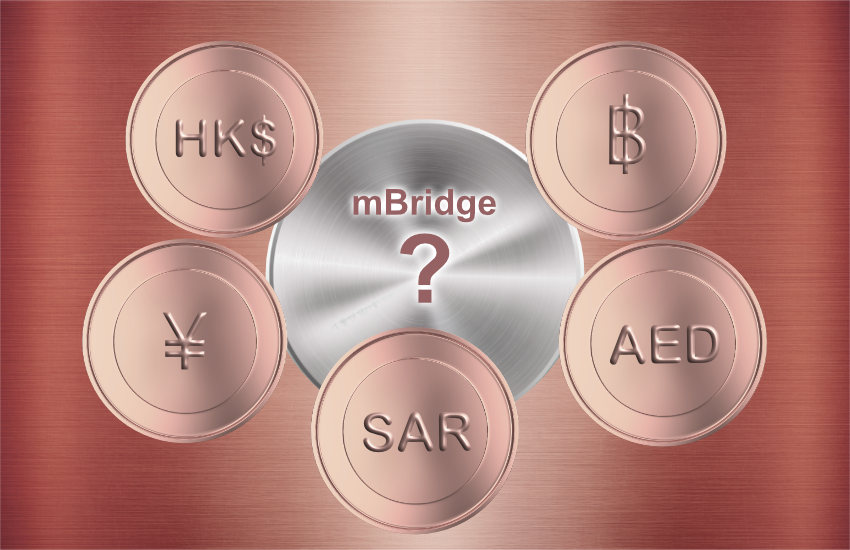🌐 BIS debates ending cross border CBDC project mBridge – report 🌐
Yesterday Bloomberg reported that the Bank for International Settlements (BIS) is considering whether to shut down Project mBridge, the cross border CBDC payments platform developed in collaboration with the central banks of China, Hong Kong, Thailand and the UAE. In June Saudi Arabia joined at the same time as mBridge launched as a minimum viable product. Bloomberg cited sources saying the topic was discussed at last week’s International Monetary Fund (IMF) and World Bank meetings. A concern is Russia’s ongoing enthusiasm for developing a similar sounding BRICS Bridge.
At a Group of 30 event in Washington on Saturday, BIS general manager Agustín Carstens was quoted as saying “we cannot directly support any project for the BRICS because we cannot operate with countries that are subject to sanctions — I want to be very clear about that.” Both Russia and Iran are BRICS+ members.
mBridge’s design
mBridge enables commercial banks to make cross border payments via their central banks, using wholesale central bank digital currencies (wCBDCs). The design encourages direct local currency payments, sidestepping the need to use US dollars.
For cross border payments, banks often either use correspondent banks or keep bank accounts (nostro accounts) at the destination, which are expensive to maintain as they tie up capital. Hence, there are pros and cons with the mBridge design. A key advantage is banks don’t need to keep nostro accounts at the destination or use correspondent banking, saving considerable money.
On the flip side, a key reason for using the US dollar as an intermediate currency is because almost all currencies have their optimal FX rates against the dollar. In other words, local currency payments involve less attractive FX rates, which is why they haven’t taken off in a big way.
There’s some simple math involved here. Currently, there are 180 currencies, each with their best rate against the dollar. That’s 180 currency pairs, with relatively strong supply and demand. So it’s cheaper to go from Thai baht to USD to renminbi, than directly from baht to renminbi. That’s because the direct local currency route for 180 currencies translates to 16,110 currency pairs. If you spread the supply and demand across 16,110 pairs rather than 180, these are far more thinly traded so you no longer get good FX rates.
An obvious path is to choose an intermediate currency different from the US dollar. Notably, BRICS countries don’t seem keen on that. This FX cost issue is critical to mBridge’s viability, because FX makes up the largest proportion of cross border payment costs, by far. State-owned Chinese companies might feel obliged to use local currencies, but companies in other economies will demand the cheapest path.
China’s role in mBridge
China chairs the mBridge technical working group and developed some proprietary components, including a Chinese blockchain consensus mechanism. The Bloomberg piece was critical about allowing China such an important role in the project. China’s role is even greater because Hong Kong is involved and the UAE’s central bank representative spent a large part of his career at the Hong Kong Monetary Authority. So three out of the four central banks have strong Chinese ties. However, the project started as a joint Hong Kong – Thailand initiative, so its location at the Hong Kong BIS Innovation Hub and the involvement of China were natural paths.
However, it’s not surprising the topic is being debated. Ledger Insights featured an opinion piece exploring the BIS dilemma in January. It concluded that if mBridge proves viable, then the central banks are likely to proceed with or without the BIS. Although it depends on their contracts with the BIS.
Since the January post, the BIS has launched Project Agorá, another cross border CBDC project, but one that supports correspondent banking. Unlike mBridge which has two BRICS members in China and the UAE, no BRICS members are involved in Agorá.
At SIBOS last week, two pieces of mBridge news reinforced the existence of this BIS debate around its future. Firstly, there was a surprising discussion about potentially integrating with Swift and even possibly including the dollar in future.
The second piece of news was the plan to open source the mBridge software. On the one hand, this might help to alleviate concerns about the dependence on China. However, it also makes it far easier for sanctioned countries to spin up a version of their own, without involving the BIS.
Should the BIS remain engaged?
In our January opinion piece, we concluded that IF mBridge proves viable, the central banks are likely to continue, with or without the BIS. With open source software, that’s even more probable. However, with the BIS involved, sanctioned countries will be prevented from engaging.
Payments are all about network effects. So if many more countries join mBridge rather than BRICS Bridge, that will support the effectiveness of sanctions and prevent mBridge morphing into BRICS Bridge. It brings the issue into focus: is mBridge about new payment efficiencies, or is it about an alternative to the status quo with the US dollar at the core?
At SIBOS, the former Governor of the People’s Bank of China, Zhou Xiaochuan, noted that “If the U.S. government would like to use the U.S. dollar as a sanction tool, it may reduce the feasibility of other countries to use the U.S. dollar.” No matter one’s view on Russia or Iran, Governor Zhou’s statement is factual. Whether it’s mBridge or something entirely different, logically there will be strategies to circumvent using the dollar. We’ve reported on Russia iterating through several different paths, many involving crypto or DLT.
However, in the case of mBridge, the genie is already out of the bottle. It’s likely better for the BIS to engage than not.
https://www.ledgerinsights.com/bis-debates-ending-cross-border-cbdc-project-mbridge-report





























